|
Portland Vase
Answer
to Name
This Famous Antique Game - December 2012
by Mike McLeod
Teresa P. Bland, Peggy Kerner of Pound Ridge, N.Y. (an avid collector of Wedgwood pottery and lecturer on the subject), Sherry Blanton and Julie Kimbrell of Old School Antique Mall in Sylva, N.C.; and Lou Gasbarro correctly identified the Portland Vase.
|
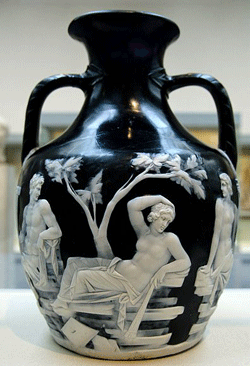
|
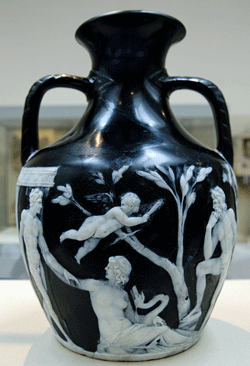
|
The Portland Vase,
front and back.
|
A masterpiece of cameo glass more than 2,000 years old, the Portland Vase had a cloudy history in the beginning. It is thought to have been created in Rome either between 30 BC and 20 BC or 5 AD and 25 AD. It is a miracle in glass manufacture. “Recent research has shown that the Portland vase, like the majority of cameo-glass vessels, was made by the dip-overlay method, whereby an elongated bubble of glass was partially dipped into a crucible…of white glass, before the two were blown together. After cooling, the white layer was cut away to form the design.” 1 The outer white glass was meticulously carved away, leaving figures of men, women, plants, a sea snake and a Cupid figure. It is believed that only an expert gem carver could have produced such artistry in glass.
If the cloudy history is correct, the vase was discovered in the tomb of Alexander Severus (Marcus Aurelius Severus Alexander Augustus) who ruled as emperor of Rome from 222 A.D. until he was assassinated by his own army in 235 A.D. The first written record of the vase did not appear until 1601 when it was owned by Cardinal Francesco Maria Del Monte. From him, it passed into the hands of the Barberini Family (among the owners in the family was Pope Urban VIII), then to Donna Cornelia Barberini-Colonna, James Byres, Sir William Hamilton, Margaret Cavendish Bentinck (the Duchess of Portland, hence the title of the vase), William Cavendish-Bentinck (her son, the third Duke of Portland), and then through the dukes four to seven of Portland. It was placed on display in the British Museum in London in the early 1800s and finally purchased by the museum in 1945.
|
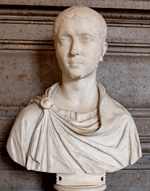
|
The Portland Vase is said to have been discovered in the tomb of Emperor Alexander Severus; this marble sculpture of him is in the Palazzo Nuovo in Rome.
(Credit: from the Vatican, gift Pius VII, 1800-1823.)
|
|
|
|
|
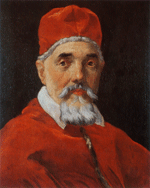
|
Ca. 1625 portrait of Pope Urban VIII by Gian Lorenzon Bernini (1598-1680).
|
|
|
|
|
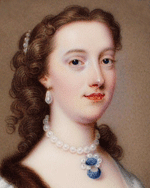
|
Margaret Cavendish Bentinck, the Duchess of Portland, a previous owner and for whom the Portland Vase is so named.
|
It was in the British Museum in 1845 when a man described as drunk or deranged smashed it into nearly 200 pieces, with no explanation as to why. The vase was reconstructed as best as possible at the time, but quite a few pieces were left over in the end. More than 100 years later, the adhesive had decayed so the vase was deconstructed and re-constructed again.
Alas, the adhesive again suffered from aging, and it was reconstructed a third time in 1988-1989. Professionals carefully disassembled and reassembled the vase with almost all of the previously unused fragments. Filled crack lines can are evident upon close inspection, but so also is most of the original beauty of the vase.
In 1790, the vase was loaned to Josiah Wedgwood who attempted to make a copy out of jasper. After months of trial and error, he also created a masterpiece. “The first edition of 30 vases was a huge success, and Wedgwood would go on to reissue the design many times.” 2
|
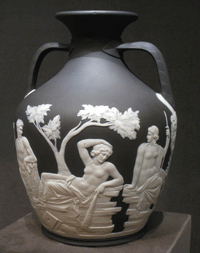
|
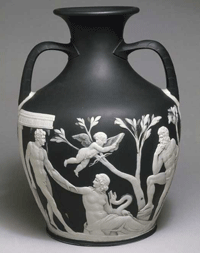
|
One of the copies (front and back) of the
Wedgwood Vase by Josiah Wedgwood.
|
Wedgwood is said to have sent the first copy to Erasmus Darwin, grandfather of Charles Darwin.3 Wedgwood put his work on exhibition, and it drew such crowds that tickets were issued for some viewings to ensure those attending could see it. Today, Wedgwood copies are in the Victoria and Albert Museum in London, the Metropolitan Museum of Art in New York, and the Indianapolis Museum of Art.
Wedgwood (the company) continued to make copies over the years. In March 2012, one from the 19th century, with abrasions and “Wedgwood” stamped on the base, sold for $1,600.4 “In 1980, a number of Portland Vases were made to commemorate what would have been Josiah’s 250th birthday.” 5
The website (www.wedgwood.co.uk) now offers the Wedgwood Portland Vase in four versions: blue with white cameo for $2,500; white with blue cameo, $1,500; black basalt with yellow cameo, $3,200; and black basalt with white cameo, $8,000.
The Wedgwood copies are exquisite; yet, they do not equal the original. Like a Mona Lisa in glass, the Portland Vase is a masterpiece, a miracle in glass, and a world-famous antique.
---------------------
1 The British Museum, www.britishmuseum.org.
2 Glendale Community College, “History of World Ceramics”.
3 Suite101, Creation of the Wedgwood Jasperware Portland Vase,
http://suite101.com/article/creation-of-the-wedgwood-jasperware-portland-vase-
a235541
4 Liveauctioneers.com for Brunk Auctions.
5 Suite101, Creation of the Wedgwood Jasperware Portland Vase.
|